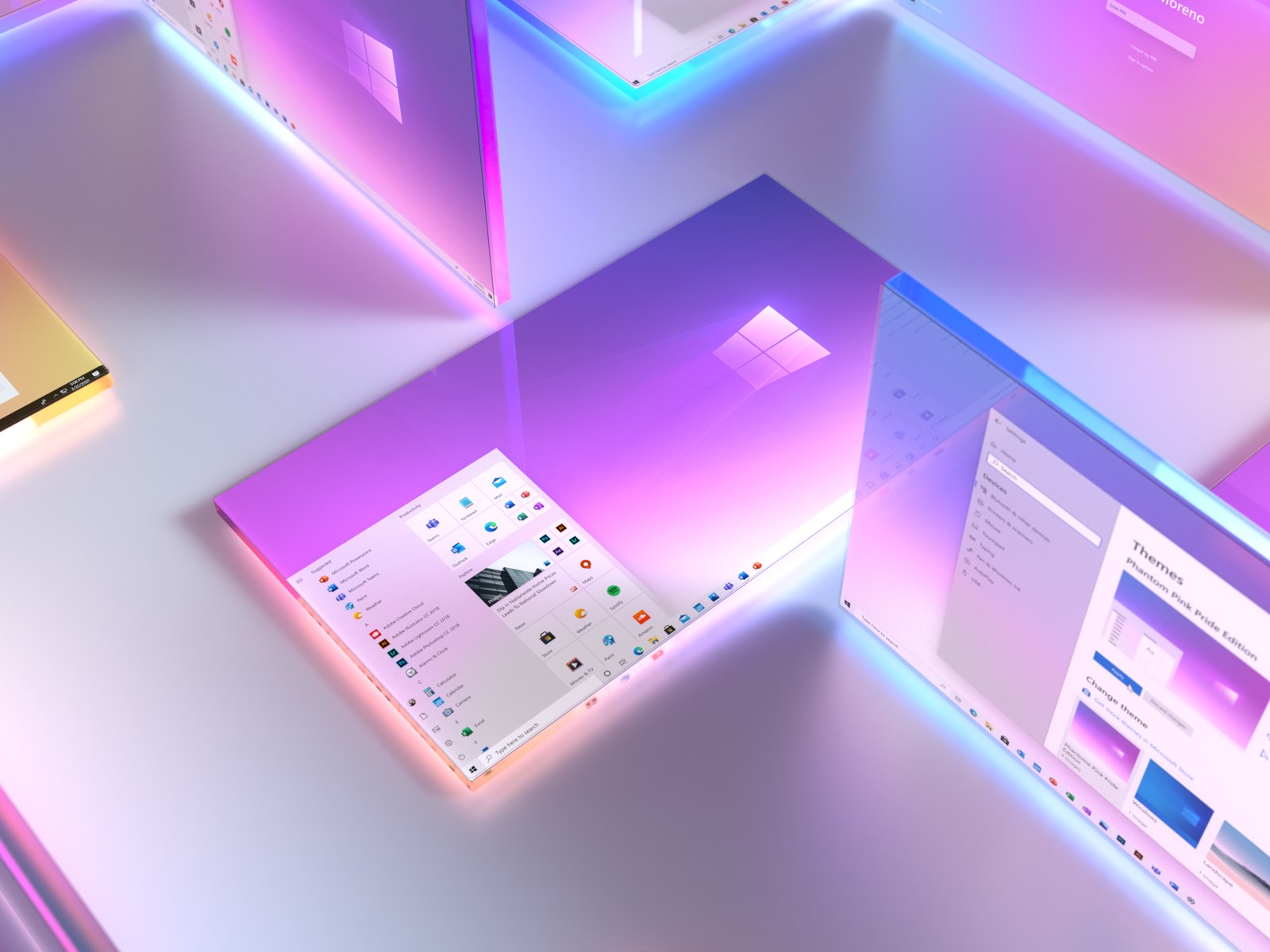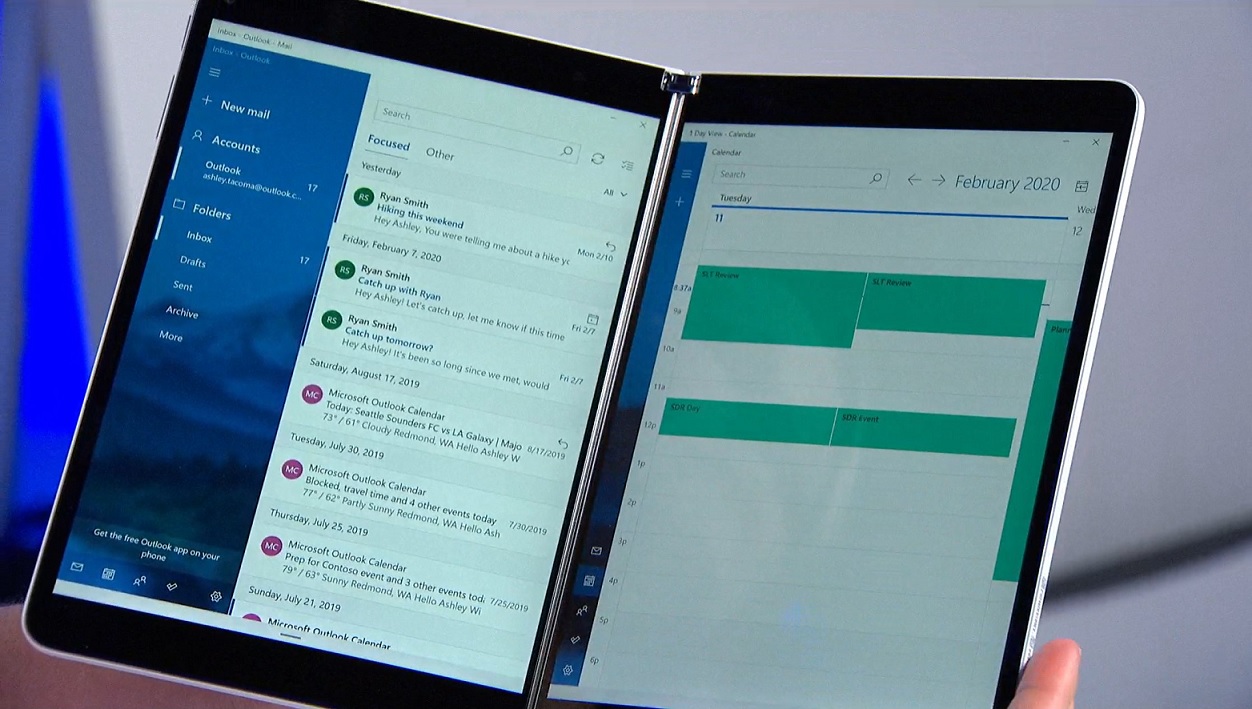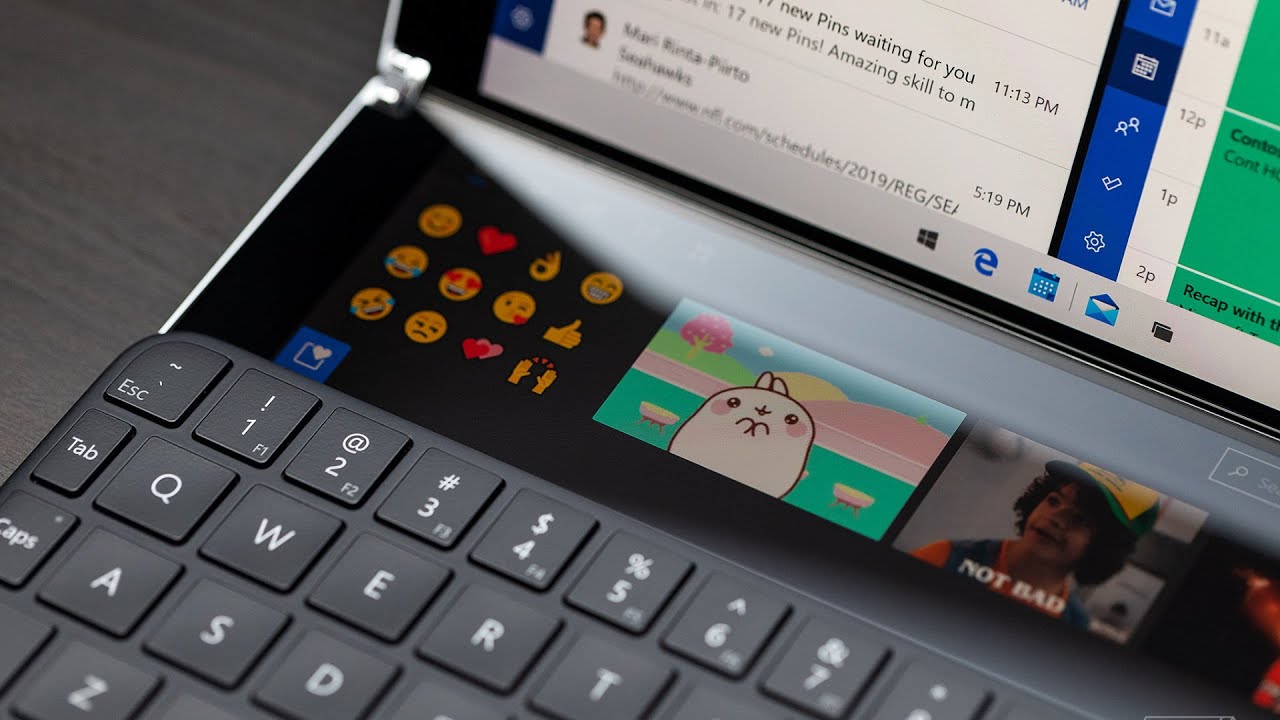The search bar is prominently displayed and functions similarly to Windows 10. However, Microsoft eliminated many of the legacy components and features you would expect to see in a Windows platform. For those of you who have grown tired of listening to Cortana while setting or resetting a new Windows 10 device, well, you can now enjoy the sound of silence with a Cortana free setup experience. Since Windows 10X has a modern core, legacy components such as the classic File Explorer are no longer present.
This means Microsoft has built a new File Explorer specific to Windows 10X, and it's built around OneDrive. Windows 10X is a web-first OS, and that includes how you store and manage files on your Windows 10X PC. By default, all your files are synced with your OneDrive account in the cloud while also being available locally on the device. Whether you prefer the device in laptop, tablet, book, or "tent" mode, Windows 10 fluently adjusts to ensure the best user experience. The taskbar adapts to its hosting device as well, spanning both screens of a dual-screen device. You can effortlessly drag and drop apps and windows between multiple screens and specify which screen you want each app.
Windows 10X was a new version of Windows that has been built from the ground up for new PCs, and was supposed to begin shipping on hardware in 2021. It's built on top of a new modern version of Windows called 'Windows Core OS' that guts legacy components and features in favor of contemporary user experiences and enhanced security. End-users might see its most outward-facing feature first; that is, it will provide a way to accommodate foldable PCs and dual-screen laptops. We predict significant demand for these devices due to their innovative design and plethora of use cases.
With Windows 10X, Microsoft is hoping to compete directly with Chromebooks for minimalistic, secure, browser-based laptops built on the Windows 10 platform. Windows 10X featured a new shell — the user interface — that was built with modern technologies. It's an adaptive user experience that can adjust depending on the "posture" of your device. For example, with a foldable PC, the user might want to use it in several different ways; as a laptop, or tablet, or in tent mode for movies. Because of this, the user interface must adapt to provide the best experience no matter which way your device is being used. As we hinted at, the interface is the key difference between Windows 10 and Windows 10X. Windows 10 is designed for devices like laptops or tablets with just one screen.
So, that means you'll see icons at the bottom of the screen for your Start Menu, apps, and programs, as well as the date and time. Unlike Windows 10, Windows 10X featured something called "state separation" which is how the OS lays itself out on a drive. Windows 10 today installs everything into a single partition, which means the user can access system files, as can apps and potential attackers.
So OS files are locked away, as are app files, as are drivers, and the registry. The only thing the user and applications can access are the user partition. So, just like on Android and Chrome OS, when the update is ready to restart your PC, it'll just restart like normal, and won't take 15 minutes to finish installing before you're back up and running.
Microsoft had redesigned the Start menu experience on Windows 10X with a focus on productivity. It features a system-wide search bar along the top that can also search the web, and a grid of installed apps below that in place of live tiles. Since every part of Windows 10X has been redesigned, the out of box experience has too been updated with a modern look and feel.
It still walks you through the Windows setup process, selecting your language, signing-in with a Microsoft Account, and agreeing to terms and conditions, but Cortana is no longer present throughout the set up process. It's a more traditional setup experience, that's been beautified on 10X. From what we know, it is shaping up to look like Windows 10X will mainly remain exclusive to the devices with dual-screens.
There is, however, some indication to reference to a "levers" feature in leaked documenation that it might come to traditional clamshell laptops too, but that is unconfirmed. Instead, you can expect for Windows 10X to remain exclusive to dual-screen devices like the Surface Neo, and other devices from Dell, HP, Lenovo, and Asus. Coming down to choosing which operating system is right for you, they'll be a few things to consider.
In 2020, if you opt to buy a new dual-screen device running Windows 10X, they'll likely be a learning curve. You'll need to get used to the new Start Menu, as well as the taskbar layout. Microsoft will likely keep updating Windows 10 as always, so, if you're still using a old Windows 10 clamshell, you'll feel right at home. All apps on Windows 10X run in a container, and need explicit permissions to access things that are outside that container. This is already how UWP apps work on Windows 10, and Microsoft will be extending that to Win32 apps on Windows 10X when support for Win32 apps arrives.
It now shows up right away in Windows 10X and you won't need to slide up to dismiss it. Although there were no screenshots to prove it, rumor has it that the settings app will also be redesigned with "waves" to cut on on the need to navigate through menus. They'll even be a new "Modern File Explorer" which is heavily optimized for touch, unlike in current versions of Windows 10. It will essentially serve as a "launcher" with a search bar on the top, a list of apps and websites, and suggested content on the bottom. There's no live tiles, like in current Windows 10, and icons are rather static.
On tablets, users can now swipe up anywhere on the Taskbar to access the Start menu, making it easier for touch users to access their apps list. You no longer have to hit the specific Start button to access your Start menu. It also has a "recent activities" area that dynamically updates with things the user might want to jump straight into, such as recent Office documents and visited websites. The apps list can be customized, with the ability for users to rearrange which apps show up in the first few rows.
As for release date, Microsoft hasn't said much about when you can expect to see Windows 10X go public. It showcased a prototype version of the OS during its Surface event, and mentioned that devices with Windows 10X will be coming in holiday 2020. That means you won't be seeing it until November or December 2020 at the earliest. Right now, when you go out and buy a new laptop, you technically get a Windows 10 license included with it at no extra cost. However, you also can head to a retail store, or buy a copy from Windows 10 if you want to build your own system. But, based on current rumors, it looks as though that this won't be the case with Windows 10X.
Microsoft is also putting some extra efforts into developing for Windows 10X. It said that developers don't have to do anything to make their apps work with the operating system. The app should adapt to Windows 10X and dual-screen devices, in either the one-pane, or two pane mode. Apps should prove even more stable on Windows 10X as they operate within three unique containers – the Win32 Container, Full-trust MSIX Container, and UWP container.
Is Windows 10X Better Than Windows 10 The process allows apps to run isolated from the OS, improving both device security and performance reliability. Nobody likes the considerable download and update process for a traditional Windows 10 machine. Feature updates for Windows 10X will now fully install in the background without rebooting the device to complete the process. Like your cell phone, a prompt will alert you to reboot once the update process finishes.
Windows 10X is about creating an adaptive user experience that automatically adjusts to the posture of the device. Unfortunately, Microsoft has announced that development on Windows 10X has been postponed and will not be launching on new PCs this year. In fact, it's unlikely Windows 10X will ever launch now that Microsoft is working on a big new user experience refresh for Windows Desktop codenamed Sun Valley and expected to launch at the tail-end of this year. A big difference from the regular version of Windows 10, the Start Menu in Windows 10X will sit on the left side screen on dual-screen devices.
Windows 10X, however, changes that in favor for a new interface for devices that have two screens, one on the left, and one on the right. There's currently five things that we know about it, judging from early leaks. Despite these setbacks, Windows 10X should be able to contend for market share against Chrome devices.
Windows 10X offers a simplified and streamlined experience that many PC users are more than ready for today. Preventing ransomware is a top cybersecurity priority, but mitigating the risk is easier said than done. According to an article by Cybercrime Magazine in 2018, it was predicted that a new business would fall victim to ransomware every 14 seconds in 2019, and by 2021, that time would decrease to just 11 seconds. To help you protect your Windows 10 desktop environment from ransomware, we've compiled a list of 24 crucial steps you should take into account today! You should use these steps in conjunction with one another as part of a multilayered strategy; do not depend on any one of them individually.
This should result in updates that take less than 90 seconds to reboot. This is a huge improvement over how Windows 10 does updates today, which can take anywhere between 5 minutes and 20 minutes to reboot, depending on the device. Based on what we know, it is looking as though Microsoft is ensuring that Windows 10X will have the maximum app compatibility. This means that just like Windows 10, all of your Windows 10 or Win32 applications will still work in Windows 10X. There's no restrictions as to what can be downloaded in the Microsoft Store. Compared to the regular version of Windows 10, Windows 10X will feel a bit more like the experience with an iPad. Microsoft will also work on a system known as "levers" which will allow you to pull up the taskbar, similar to the dock in iPadOS.
The new OS should be available for single-screen PCs geared towards business and education use sometime in 2021. Microsoft has now stated that the pandemic has caused them to alter their plans. There are also appear to be some glitches with it running Win32 applications and integrating with folding PC technology. While Microsoft's original intention was to package Windows 10X with new dual-screen devices such as the Surface Neo at the end of 2020, things have changed. That shouldn't be surprising in a year in which it seems that everything has changed. Ever wondered what Microsoft's canceled version of Windows for the Surface Duo was going to be like?
Well wonder no more, as we've got a very first hands-on look at a pre-release build from mid-2018 running on a Lumia 950. We've already shown you what Andromeda OS looked like in recreated mockups, so now it's time to see the real thing running on video. In addition to the new Start and Taskbar experiences, there was also a new Action Center to compliment them. This new Action Center puts more emphasis on quick actions, with the ability to jump into specific quick actions for further control without leaving the Action Center at all. Heading into holiday 2020, you'll notice that there's a new flavor of Windows 10 in town.
As announced during its October 2 Surface event, Microsoft is working on a new version of Windows 10 for a wave of foldable PCs like the Surface Neo. As a result, Microsoft is proposing to release Windows 10X for traditional form factors. Instead, the popup like menu looks more like your cell phone menu, and users can customize it to maximize productivity. You'll have a "recommended" area where users can access Office documents, folders, and other types of things they need to access quickly.
Microsoft has redesigned the Start menu experience for Windows 10X into something they call a Launcher. Well, there is a sizable change coming in the Windows 10 world, and its called Windows 10X. Codenamed Santorini, Windows 10X is significantly different from the Windows 10 you manage today. Twice a year, Windows 10 deals with a new feature or setting to manage Group Policy or MDM.
It's also designed in such a way that mimics a control center, with notifications housed above it in a separate box. This new Action Center includes things like volume controls, power options, and battery percentage. There's also a new music control UI that appears in the Action Center when music is playing from a supported app. Either way, this article remains as a look-back at some of the new experiences and changes Microsoft had pioneered with Windows 10X. When removing an app, you remove an app—no difficult to remove junk, registry exorcism, or file scraping. But Microsoft can't compete in this market without making some changes.
NVIDIA's new DLDSR downscaling technique only adds to its growing collection of acronyms. Upgrade your lifestyleDigital Trends helps readers keep tabs on the fast-paced world of tech with all the latest news, fun product reviews, insightful editorials, and one-of-a-kind sneak peeks. This all means that Windows 10X isn't something you can purchase on your own.
Instead, it is an operating system that's linked to your device, just like how you can't go out to the store and buy a copy of iOS for your iPhone or iPad.























No comments:
Post a Comment
Note: Only a member of this blog may post a comment.